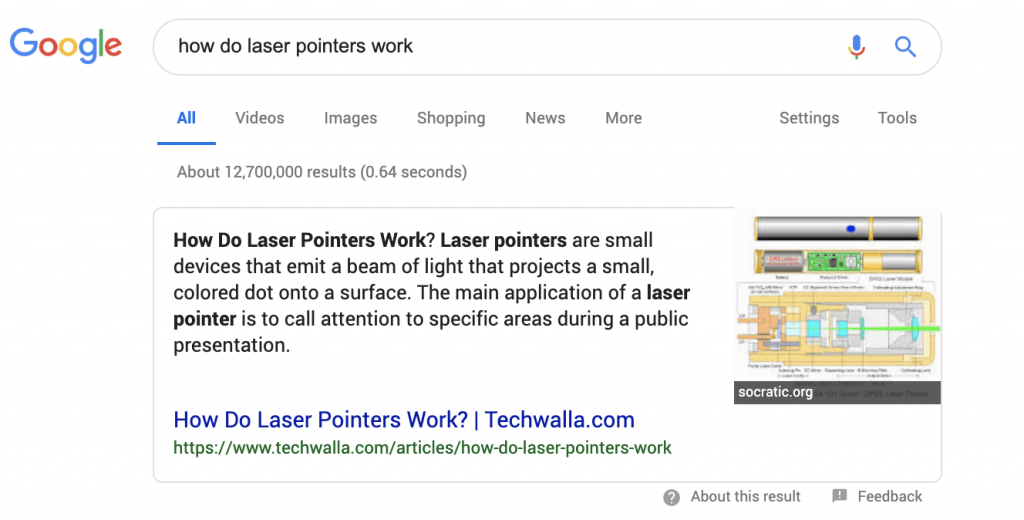Google’s featured snippets account for 35.1% of all clicks in the organic search results. Moreover, a featured snippet is like a golden ticket to the very top of the SERPs – even above position one.
This mythical no-man’s land goes by the name position zero since it appears above the organic results.
If you’ve ever entered search queries that ask questions into Google, you’ve likely come across a featured snippet (or at least if you’ve used Google since 2014).
A snippet is a brief paragraph, video, list, or table that partially answers the query and encourages users to click to learn more.
If you want your website to rank higher and generate more organic traffic, you’ll need to know how to optimize for featured snippets.
That’s why we put together this guide for implementing featured snippets into your SEO strategy. Read on to discover how you can identify featured snippet opportunities and optimize your content for them.
What Are Featured Snippets on Google?
Starting in 2014, Google added featured snippets to its SERP features. To date, it’s still one of the most significant additions to Google’s search engine – and has drastically changed the SEO landscape as a result.
Google is always looking for ways to match user queries with the relevant content in the quickest and most convenient way possible, leading to the birth of the featured snippet.
It’s a unique search result that appears at the top of Google search results, even above the #1 ranked organic listing.
It contains a brief ‘snippet’ of information that Google believes either answers the user’s question or provides enough value to entice them to click and learn more.
As you can probably guess, you don’t want to answer the question outright in the snippet, as that can lead to losing a click. The best-featured snippets for SEO are ones that provide a partial answer but leave enough out, so the user clicks on your link.
Regardless, any type of featured snippet is excellent for brand-building and leads to a higher click-through rate (CTR), so they’re worth pursuing.
Where does Google pull featured snippets?
From existing pages in its index – most commonly pages that already rank in the top 10 or top 5. For this reason, featured snippets are the most powerful when you combine them with an already robust and successful SEO strategy.
To learn more about featured snippets and other SEO fundamentals, check out our Learning Hub.
The elements of a featured snippet
Each featured snippet will contain the following components, regardless of the type:
- Relevant content to the search query
- The title of your web page
- The unique URL
- An image from Google Images that matches the keyword
A featured snippet can take on a few different forms, not just a paragraph of text, so let’s break down each one.
Learning the Types of Featured Snippets
There are a few ways that Google presents its featured snippets. While the most common type is a paragraph snippet, there are three other ways a snippet can present content.
Paragraph Snippets
A paragraph snippet displays a brief bit of information pertaining to the topic. If you want to boost your click-through rate, you should optimize for paragraph snippets the most.

That’s because a paragraph usually isn’t enough space to fully answer a question, only to hint at it or provide a partial explanation.
Paragraph snippets always appear with images on Google SERPs – yet these images aren’t always from the snippet website. Instead, Google will select an image from its library to match the search intent.
In the example above, the snippet contains related terms that searchers can click on to find other featured snippets. This is the ‘people also ask‘ section. If you click on one of the terms, the search query will change to the selected term, and you’ll see the new snippet for it.

Remember, featured snippet optimization is all about encouraging your readers to click on your link to learn additional information. When writing paragraphs that you want to become snippets, don’t provide all the answers in them.
List Snippets
Sometimes Google will present a featured snippet in a list format. This can take on two forms, bulleted lists or numbered lists.

Google favors the list format for:
- Queries that require a set of instructions
- Recipes
- Things that rank in a specific order (movies in a franchise, books, etc.)
- Listing the ‘best’ of something (software tools, TVs, etc.)
- Checklists
Google will typically use an HTML element from your website to create the lists.
Table Snippets
The table snippet is the third and most rare form of a featured snippet. Google will display

a simple table containing relevant information to the search query for these results.
To do so, Google will take information from HTML elements and compile it into a table.
For the most part, table snippets are reserved for queries related to statistics and figures. An example would be searching crime rates for a particular city.
Video Snippets
Lastly, Google will sometimes link to a related YouTube video in the featured snippet – complete with a timestamp on the spot in the video containing the answer to the query.

They show up as ‘suggested clips’ – and only videos from YouTube make the cut (which makes sense since Google owns it).
You won’t need to worry about optimizing for video snippets if you don’t create marketing videos. Even then, it’s difficult to tell when, where, and why Google will use a featured snippet from YouTube.
Google’s Other SERP Features That Aren’t Featured Snippets
Besides featured snippets, Google has other SERP features that look shockingly similar to them. Yet, it’s crucial to distinguish the difference, as your SEO will only benefit from featured snippets, not knowledge cards or entity carousels.
In other words, you can optimize for featured snippets to heighten your chances of ‘winning’ one.
You can do no such thing for the other SERP features, as they’re random and don’t highlight one particular website in the SERPs.
Knowledge cards and entity carousels
A knowledge card appears nearly identical to a featured snippet with one key difference – it doesn’t draw information from one website. Instead, all the data comes from Google’s Knowledge Graph.
These features are Google’s way of enhancing its user experience and don’t have anything to do with SEO.
Knowledge cards and graphs often answer quick questions (such as a company’s founding date), make a calculation, or provide weather forecasting. You can think of them as answer boxes instead of featured snippets.



An entity carousel is a series of links that list related topics. You might see an entity carousel if you Google a band’s discography. All their albums would display from left to right, allowing you to scrub through them.
It’s also very common for the cast and crew of a movie to appear as an entity carousel. Each ‘entity’ contains a link to each actor and crew member’s IMDB page.
Some Featured Snippet Statistics:
Results from a study conducted by Mangools:
- 41% of queries on Google display a featured snippet.
- There are an average of 272 characters per paragraph snippet.
- 23% of all comparison keywords have featured snippets.
- 7% of generic keywords display a featured snippet.
- Nearly all (99%) of question queries have paragraph snippets – except for ‘how’ questions. For those, 52% displayed list snippets.
- A list snippet will never contain more than eight items.
- A majority (70%) of featured snippet URLs use HTTPS.
What Can Featured Snippets Do For You?
These benefits should change your mind if you’re on the fence about optimizing for featured snippets.
Primarily, any web page containing a featured snippet will have a higher CTR than one without.
In fact, Hubspot found that, on average, content containing a featured snippet will have a 2x higher CTR than unfeatured content.

That means even if you suspect your featured snippet answers the question and ends up losing clicks – you’ll still be better off with it than not.
The proof?
Moz‘s Cyrus Shepard conducted an experiment where he opted out of Google’s featured snippets. So even if one of his articles is a prime candidate for a snippet, Google can’t use it.
The thinking behind the experiment was that snippets take away from your organic search rankings and cause you to lose traffic – such as a snippet answering a user question, so they don’t need to click through.
The results found exactly the opposite. As soon as his posts lost their featured snippets, he saw a 12% dropoff in traffic that happened almost immediately.
That’s proof that it’s always beneficial to have a featured snippet working for you in position zero.
Besides more organic traffic, featured snippets are excellent tools for brand-building. Users will remember that you answered your question, and the fact that you rank so high on Google reflects well on your brand.
How to Earn Featured Snippets
All right, now that you know it’s worth optimizing for featured snippets, how do you do it?
You’ll want to incorporate the featured snippet style into your content marketing strategy. We recommend taking a two-pronged approach to the process:
- Use ‘snippet-friendly’ keywords. Specific keyword phrases, such as ‘how,’ ‘recipe,’ and ‘best,’ tend to appear in featured snippets more than others. It would be best if you also focused on keywords that ask questions.
- Optimize content for snippets. We’ll go into more detail on this below, but you’ll want to tweak your content in specific ways to heighten the chances of Google displaying a snippet.
Let’s go into more detail on each part of the process.
Featured Snippet Keyword Selection
As with discovering any keyword, it all starts with how you conduct research. For snippets, there are a few online tools you can use.
There are a few places you can look to find the keywords you should target to earn featured snippets for your site. First off, you can use our free keyword planner tool to conduct in-depth research.
It would help if you also turned to your Google Search Console (GSC) account to see which keywords you’re already ranking high for – as these are most likely to trigger a snippet.
To do so, open up GSC and go to the Search Results Performance Report. Next, filter the data to only display keywords that ask questions. You’ll have to do this one question word at a time due to GSC’s limitations.

Sort the queries to show the highest-ranking keywords first. The top 10 keywords are the ones you should optimize for featured snippets first.
Another technique is to use a keyword research tool that displays SERP feature data. For this, we recommend using WooRank’s Keyword Tool. It will let you know if a keyword is likely to show up in a featured snippet or not.

You should look for:
- Web pages that already rank high on the search engine results page (top 10 or top 5).
- A web page that isn’t ranking #1, as the featured snippet will drive you over the top and beat out the competition.
- A keyword that will trigger a snippet that doesn’t entirely answer the question.
- Keywords with informational intent.

Beyond targeting keywords, you can also optimize your content for featured snippets. That way, you’ll be set up to claim a featured snippet if Google decides to display one for your keyword.
Optimizing Content for Featured Snippets
Once you have question keywords with informational intent, it’s time to create quality content centered around them.
Hubspot discovered that on-page SEO matters far more for featured snippets than backlinks. That means once you’ve penetrated the top 10, it’s all about optimizing your content more than it is acquiring more links.
But how should you tweak your content for featured snippets?
Here are some general guidelines for writing content that Google is likely to feature in a snippet:
- Pose the target question in a header (H1, H2, H3, etc.), preferably the H1 header.
- Don’t forget the <p> tag. Immediately after posing the question, use a <p> tag, and then include the content you want for the featured snippet. If it’s a paragraph, write some text. If it’s a list, include bullet points and so on.
- Provide a concise answer that encourages users to read more. You’ll have about 50 words to work with here, so think hard about what you want to say.
- Answer related questions later on in the content. Once you’ve answered the target question, back it up with supplementary questions. I.e., if it’s ‘what is a guitar?’ You could follow up with ‘how do guitars work?’
- If you’re going for a list or table snippet, use structured data markup for them.
- Write naturally and follow a logical structure. It’s crucial not to overthink it when optimizing your content for snippets. Instead, write as you normally would and consider readability and flow. The last thing you want is for your content to appear unnatural because you injected too many keywords.
In a nutshell, you want to create high-quality content that answers customer questions. After that, run a savvy link-building campaign to get that content on the first page of Google (where it stands the highest chance of getting displayed as a snippet).
Track Your Existing Featured Snippets
You should closely monitor the featured snippets that your website has while working on claiming new ones.
Doing so will benefit you in the following ways:
- Know how your site will appear on search engines. SERPs with tons of features will push the #1 organic result further down the page. Knowing this can help you select the right keywords for your website.
- Understand how Google views the intent behind search queries. That way, you won’t be shooting in the dark with your target keywords.
- Locate opportunities where you can beat out competitors. The higher that you rank on SERPs, the harder it will be to advance any further. For example, if you’re ranking fourth for a keyword, a featured snippet can act as a shortcut to drive you over the top.
The WooRank tool will enable you to see which keywords have featured snippets and which don’t. You’ll also be able to see the domain for the page in the snippet.

Additionally, you’ll be able to see the featured snippets for 3 of your competitors. That helps you get a complete picture of how you’re performing compared to others.


Concluding Thoughts: Optimize for Featured Snippets
By now, you should have a better understanding of how to leverage Google’s featured snippets for your SEO.
Featured snippets are all about obtaining the legendary position zero for your content at its core. Doing so will always enhance your CTR, which is a huge benefit.
So if you want to circumvent the #1 position and gain an explosive amount of traffic, you should optimize for featured snippets. While it takes a fair bit of work to earn a spot in position zero, the results are more than worth it.
If you lack time to pursue featured snippets for your website, you can let us handle your SEO. We offer fully managed SEO services, including content creation, link building, and optimizing for snippets.
If you’d rather receive candid advice from an expert, you can schedule a call to speak with one of our SEO experts today.








